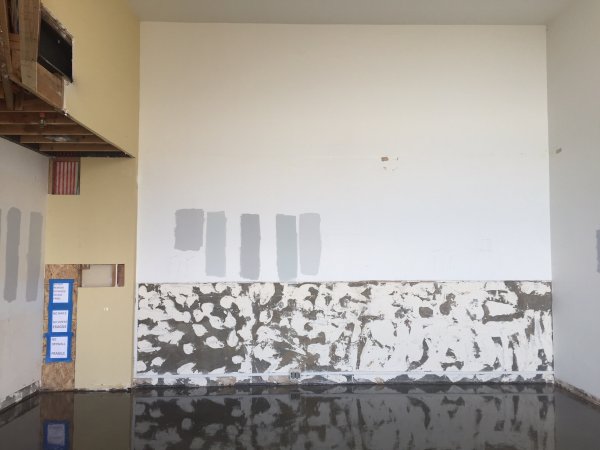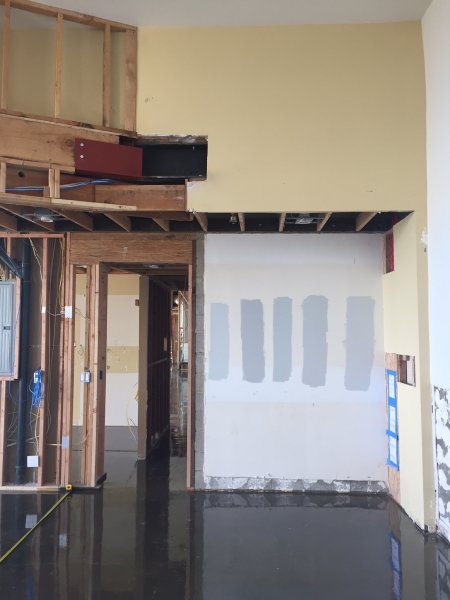I am seeking replies based on direct experience and educated theories regarding the reflection off the front wall of a rear wave launched from the rear of a dipole speaker.
Please reply if and only if you:
1) own or have owned or have had significant, long-term experience with dipole electrostatic speakers or dipole ribbon speakers; and
2) believe in not absorbing the back wave of the dipole speakers (I do not want a debate on the merits of absorbing the back wave).
How figurative or literal are we when we describe the back wave reflecting off the front wall? What is the nature of this wave?
If we could dye the backwave with a color would we see a clean and uniform wave bouncing off the front wall and retaining its waveform -- would it look like a coherent waveform? Or does the wave break up when it hits the front wall and is reflected off the front wall in "pieces"?
This is a photo of the front wall of my future listening room:

The left side of the front wall (about 42" wide) sticks out from the rest of the front wall by about four inches. You can see the side profile of the four inch step here:

Please assume the dipole ribbon speaker will be about 8 feet in front of the front wall.
Please assume the middle of the left speaker driver will be directly in front of the 4" step. (The back of the ribbon driver will pretty much be aiming right at that 4 inch corner sticking out.) I do not absorb the back wave of dipole speakers. (Again, I do not wish to debate that point here.)
Part of the rear wave of the speaker will hit the white wall (which is not stepped out by four inches), and part of the rear wave of the speaker will hit the section on the left (which protrudes from the rest of the front wall by four inches).
I am concerned about the back wave of the left speaker becoming adulterated by the different depths of the front wall right behind it.
What will be the effect of the four inch step on the rear wave when the rear wave hits it?
Will the step "break up" the rear wave?
Will the step adulterate in some way the rear wave and prevent a coherent waveform from being reflected off of the front wall and towards the listening position?
Thank you!
Please reply if and only if you:
1) own or have owned or have had significant, long-term experience with dipole electrostatic speakers or dipole ribbon speakers; and
2) believe in not absorbing the back wave of the dipole speakers (I do not want a debate on the merits of absorbing the back wave).
How figurative or literal are we when we describe the back wave reflecting off the front wall? What is the nature of this wave?
If we could dye the backwave with a color would we see a clean and uniform wave bouncing off the front wall and retaining its waveform -- would it look like a coherent waveform? Or does the wave break up when it hits the front wall and is reflected off the front wall in "pieces"?
This is a photo of the front wall of my future listening room:

The left side of the front wall (about 42" wide) sticks out from the rest of the front wall by about four inches. You can see the side profile of the four inch step here:

Please assume the dipole ribbon speaker will be about 8 feet in front of the front wall.
Please assume the middle of the left speaker driver will be directly in front of the 4" step. (The back of the ribbon driver will pretty much be aiming right at that 4 inch corner sticking out.) I do not absorb the back wave of dipole speakers. (Again, I do not wish to debate that point here.)
Part of the rear wave of the speaker will hit the white wall (which is not stepped out by four inches), and part of the rear wave of the speaker will hit the section on the left (which protrudes from the rest of the front wall by four inches).
I am concerned about the back wave of the left speaker becoming adulterated by the different depths of the front wall right behind it.
What will be the effect of the four inch step on the rear wave when the rear wave hits it?
Will the step "break up" the rear wave?
Will the step adulterate in some way the rear wave and prevent a coherent waveform from being reflected off of the front wall and towards the listening position?
Thank you!

